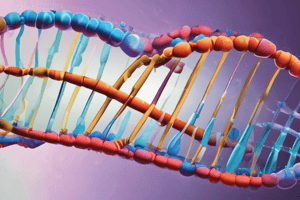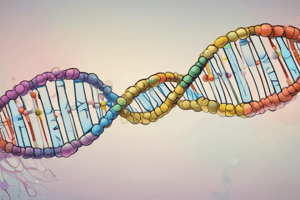Podcast
Questions and Answers
What is the main function of RNA primase during DNA replication?
What is the main function of RNA primase during DNA replication?
- To extend the new DNA strands
- To remove DNA primers and replace them with DNA
- To join Okazaki fragments
- To lay down an RNA primer for DNA polymerase (correct)
What differentiates the template for the leading strand from the lagging strand during DNA replication?
What differentiates the template for the leading strand from the lagging strand during DNA replication?
- The leading strand is synthesized discontinuously, while the lagging strand is continuous.
- The leading strand is read continuously in a 3' to 5' direction, while the lagging strand is read in the same direction, but discontinuously. (correct)
- The leading strand synthesizes Okazaki fragments, unlike the lagging strand.
- The leading strand requires multiple primers, unlike the lagging strand.
What role does DNA ligase play in the process of DNA replication?
What role does DNA ligase play in the process of DNA replication?
- It removes RNA primers and replaces them with DNA.
- It joins nicks between DNA fragments. (correct)
- It acts as a template for DNA polymerase.
- It synthesizes Okazaki fragments.
What characteristic is notable about telomeres in eukaryotic chromosomes?
What characteristic is notable about telomeres in eukaryotic chromosomes?
Which of the following statements about DNA polymerase I and III is correct?
Which of the following statements about DNA polymerase I and III is correct?
What is the correct model of DNA replication that was concluded by Meselson and Stahl?
What is the correct model of DNA replication that was concluded by Meselson and Stahl?
Which enzyme is responsible for linking new nucleotides during DNA replication?
Which enzyme is responsible for linking new nucleotides during DNA replication?
Which of the following statements about the structure of DNA is incorrect?
Which of the following statements about the structure of DNA is incorrect?
During DNA replication, in which direction does the new strand grow?
During DNA replication, in which direction does the new strand grow?
What is released during the nucleotide linkage process in DNA replication?
What is released during the nucleotide linkage process in DNA replication?
What role do regulatory proteins play in DNA structure?
What role do regulatory proteins play in DNA structure?
What is the function of DNA helicase during DNA replication?
What is the function of DNA helicase during DNA replication?
Which part of the nucleotide acts as the energy source during DNA replication?
Which part of the nucleotide acts as the energy source during DNA replication?
What was the main conclusion from Frederick Griffith's experiments regarding the genetic material?
What was the main conclusion from Frederick Griffith's experiments regarding the genetic material?
Which strain of Streptococcus pneumoniae has a protective capsule?
Which strain of Streptococcus pneumoniae has a protective capsule?
What was the purpose of Avery et al.'s experiment in 1944?
What was the purpose of Avery et al.'s experiment in 1944?
In Griffith's experiment, what was observed after R cells took up genetic material from dead S cells?
In Griffith's experiment, what was observed after R cells took up genetic material from dead S cells?
What does the term 'transforming factor' refer to in the context of Griffith's experiments?
What does the term 'transforming factor' refer to in the context of Griffith's experiments?
Why are telomeres important in DNA replication?
Why are telomeres important in DNA replication?
What role does DNA proofreading play in genetic fidelity?
What role does DNA proofreading play in genetic fidelity?
What is the primary purpose of DNA packaging in cells?
What is the primary purpose of DNA packaging in cells?
What causes telomere shortening during DNA replication?
What causes telomere shortening during DNA replication?
What is a key characteristic of Werner syndrome?
What is a key characteristic of Werner syndrome?
What was the main purpose of the Hershey-Chase experiment?
What was the main purpose of the Hershey-Chase experiment?
Which mechanism helps correct DNA replication errors as they occur?
Which mechanism helps correct DNA replication errors as they occur?
How does mismatch repair identify incorrect bases in DNA?
How does mismatch repair identify incorrect bases in DNA?
What conclusion resulted from the Hershey-Chase experiment regarding phage T2?
What conclusion resulted from the Hershey-Chase experiment regarding phage T2?
According to Chargaff's rules, which nucleotide pairs occur in a 1:1 ratio?
According to Chargaff's rules, which nucleotide pairs occur in a 1:1 ratio?
What is the typical mutation rate in E. coli nucleotides?
What is the typical mutation rate in E. coli nucleotides?
What are the four primary functions of DNA mentioned in the content?
What are the four primary functions of DNA mentioned in the content?
What role does oxidative stress play in aging?
What role does oxidative stress play in aging?
What is the primary function of telomerase in cells?
What is the primary function of telomerase in cells?
What structural discovery about DNA was made by Watson and Crick in 1953?
What structural discovery about DNA was made by Watson and Crick in 1953?
Which of the following best describes the end replication problem?
Which of the following best describes the end replication problem?
What aspect of DNA contributes directly to its function in evolution?
What aspect of DNA contributes directly to its function in evolution?
What role did Rosalind Franklin play in the discovery of DNA's structure?
What role did Rosalind Franklin play in the discovery of DNA's structure?
Which of the following statements about the components of DNA is accurate prior to 1950?
Which of the following statements about the components of DNA is accurate prior to 1950?
Flashcards
Transformation
Transformation
The process where non-pathogenic bacteria become pathogenic by taking up genetic material from dead pathogenic bacteria.
S strain bacteria
S strain bacteria
A strain of bacteria that causes disease, in this case pneumonia, and is protected by a capsule.
R strain bacteria
R strain bacteria
A strain of bacteria that does not cause disease, and lacks a protective capsule.
Streptococcus pneumoniae
Streptococcus pneumoniae
Signup and view all the flashcards
Frederick Griffith
Frederick Griffith
Signup and view all the flashcards
Griffith's Experiment
Griffith's Experiment
Signup and view all the flashcards
Avery et al.
Avery et al.
Signup and view all the flashcards
DNA
DNA
Signup and view all the flashcards
Single-strand binding proteins
Single-strand binding proteins
Signup and view all the flashcards
RNA primase
RNA primase
Signup and view all the flashcards
Leading strand
Leading strand
Signup and view all the flashcards
Lagging strand
Lagging strand
Signup and view all the flashcards
Telomeres
Telomeres
Signup and view all the flashcards
Bacteriophage (T2 Phage)
Bacteriophage (T2 Phage)
Signup and view all the flashcards
Hershey-Chase Experiment
Hershey-Chase Experiment
Signup and view all the flashcards
DNA Nucleotides
DNA Nucleotides
Signup and view all the flashcards
Chargaff's Rules
Chargaff's Rules
Signup and view all the flashcards
Base Sequence
Base Sequence
Signup and view all the flashcards
DNA Replication
DNA Replication
Signup and view all the flashcards
Phenotype Expression
Phenotype Expression
Signup and view all the flashcards
DNA Mutation
DNA Mutation
Signup and view all the flashcards
Antiparallel
Antiparallel
Signup and view all the flashcards
Right-handed helix
Right-handed helix
Signup and view all the flashcards
Regulatory proteins
Regulatory proteins
Signup and view all the flashcards
Semiconservative model
Semiconservative model
Signup and view all the flashcards
Origins of replication
Origins of replication
Signup and view all the flashcards
DNA Helicase
DNA Helicase
Signup and view all the flashcards
Topoisomerase
Topoisomerase
Signup and view all the flashcards
Telomere end replication problem
Telomere end replication problem
Signup and view all the flashcards
Oxidative stress
Oxidative stress
Signup and view all the flashcards
Werner syndrome
Werner syndrome
Signup and view all the flashcards
Elizabeth Blackburn
Elizabeth Blackburn
Signup and view all the flashcards
Proofreading mechanism of polymerase
Proofreading mechanism of polymerase
Signup and view all the flashcards
Mismatch repair
Mismatch repair
Signup and view all the flashcards
Study Notes
DNA Structure and Replication
- DNA is the genetic material of life.
- DNA has a double helix structure.
- DNA replication is a process where DNA makes a copy of itself.
- DNA proofreading and repair mechanisms correct errors in replication and environmental damage.
- Telomeres are the ends of eukaryotic chromosomes protecting them from loss of information.
- Telomeres are rich in TTAGGG sequence (in humans).
- Telomere shortening is an aging problem
DNA as Genetic Material
- 1928, Frederick Griffith experimented with Streptococcus pneumoniae bacteria.
- He used S (smooth) and R (rough) strains to show transformation.
- This indicated that genetic material was transferred, possibly DNA.
Identifying the Transforming Substance
- 1944, Avery et al. identified DNA as the transforming substance.
- 1952, Hershey and Chase used bacteriophages to confirm DNA as genetic material.
- They labeled phage DNA and proteins radioactively and traced DNA entry into bacterial cells.
DNA Structure
- DNA is a double helix.
- 1 turn is 3.4 nm.
- Distance between adjacent nucleotides = 0.34 nm.
- The structure suggests a replication method.
- A pairs with T and C pairs with G.
- DNA is a double helix with an antiparallel and right-handed orientation.
DNA Replication
- The basic idea: one strand acts as a template for making a new strand.
- Four requirements: template, complementary base-pairing, building blocks (dNTPs), and an enzyme (DNA polymerase).
- DNA polymerase needs energy (phosphoanhydride bonds of dNTPs).
- Three major steps of replication include denaturation, primer linking to start new strands and strand elongation (forming new strands).
Semiconservative Replication (Correct model)
- Meselson and Stahl study used density gradient centrifugation to separate DNA based on 14N and 15N isotopes.
- Their results supported the semiconservative model of replication.
DNA Proofreading and Repair
- DNA is subject to errors of replication and environmental damage.
- Replication is very fast in E. coli (1000 base pairs/second).
- Proofreading and repair mechanism in DNA polymerase corrects errors as DNA is made .
- Mismatch repair scans DNA to correct mismatches.
- Excision repair removes UV or chemically damaged bases.
Packaging DNA
- DNA is packaged with histone proteins.
- Nucleosomes are formed (DNA wrapped around histone octamers).
- 10-nm fiber, 30-nm fiber and 300-nm loop domains.
- Chromosomes are ultimately formed.
Telomere End Replication Problem
- The 3' end of the lagging strand template is not completely replicated because DNA polymerase can only add nucleotides to the 3' end.
- Okazaki fragments are formed in lagging strand replication.
Studying That Suits You
Use AI to generate personalized quizzes and flashcards to suit your learning preferences.




